Nicomedia hosted the Eastern Roman capital from 286 to 330 AD. This city that buried hundreds, if not thousands, of martyrs has historically been known as an essential Christian city, but is now totally forgotten. Even the churches from the past have been covered up, like the multiple layers of history that sit below the modern city of Izmit. Ten known churches can be found in the historic and archeology evidence.
This list is the 10 Churches of Nicomedia that we know of; however, one of the churches mentioned in historical records may correspond to one of those discovered during the archaeological dig. The challenge we face is that the few churches found underground remain unidentified in terms of their historical names.
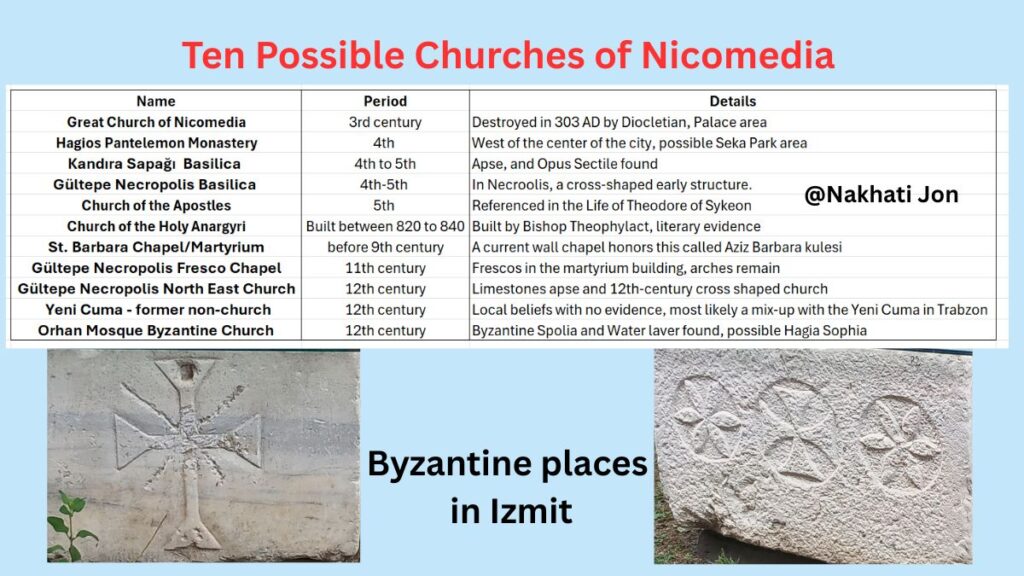
“Great Church” of Nicomedia
Diocletian destroyed this 3rd-century church in 303 AD, a remarkable fact considering that a church building existed openly during that time. The historicity of this church bears witness to the idea that churches started to be built during the 3rd century. Researchers like Boulhol suggest that this church was located near where the imperial palace of Diocletian has been found (Çukurbağ neighborhood, near Cumhuriyet Parkı). According to one source, it was visible from the palace (Lactance, Mort. Persecu., 12, 2-5). If this church existed on the western portion of the neighborhood, it could have been the Orhan Mosque area.
St. Panteleimon Monastery and Church
To the west of the Great Nicomedia Church lay the Panteleimon Monastery. Sourced from the 4th century, this was a well-known site throughout history but is less well-known today. This monastery was an urban one and close to the center of the city (Passion of Agathonicus, 7 [BHG 822z], 17, pg. 70). It was known to be on the west side of town.
Some say the church of St. Panteleimon was sold in 1675 to a man named Demetrious and then fell to the Armenians.(Boulho, 927). Supposedly rebuilt by Paisios, the Metropolitan of Nicomedia, around 1700. Also some claim it was rebuilt in 1858-60 (Kleonymos and Papadopolulos, 1867, 69). One report states that the building still existed in 1971 but was destroyed when the highway (D100) was constructed before 1986 (Firatli, 1971).[1]Another monastery was called Passion of Indes (eunuch who served Domna) and Domna (a known virgin, secretly converts, she is the king’s concubine – an official from Maximian’s rule … Continue reading It is quite possible that this monastery, with its central church, was located near the Feyziye Cami area.
Kandıra Sapağı Basilica – (4th-5th century)
In the archeology digs of 1947, Rüstem Duruyan found a three aisle basilica with mosaics. [2]R. Duyuran’s 1951 report (Belleten XV/58, p. 214–215):“Kandıra Sapağı’nda yapılan kurtarma kazılarında üç nefli ve üç apsisli bir yapı ortaya çıkarılmış olup, plan … Continue reading The location is near Kandıra Sapağı and the site has been totally buried beneath the road construction. Despite amazing pictures of a basilica and Ravenna-like mosaics, nothing of the find can be located today.[3]See: https://dergipark.org.tr/tr/download/article-file/3313802
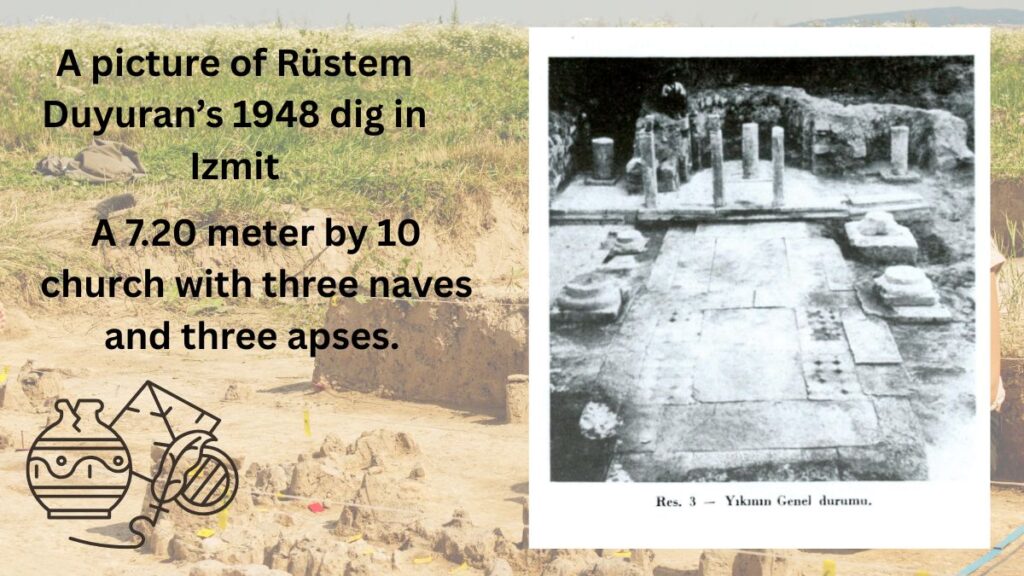
Besides the basilica, several important items have been found, such as the ‘Opus Sectile’ door, an inscription related to the building, and graves.[4]see Duyuran 1951, 213-8. With the importance of mosaics and graves, it is possible that this could be the Church of the Apostles. Like its namesake in Constantinople, it would have been located on a hill.[5]Fatih Camii is the location of the Istanbul Church of the Apostles
Unfortunately, these mosaics and this panel are not evident in the Museum nor anywhere in the city of Izmit. This could have been a key tourist site for many to see what the Churches of Nicomedia were like.
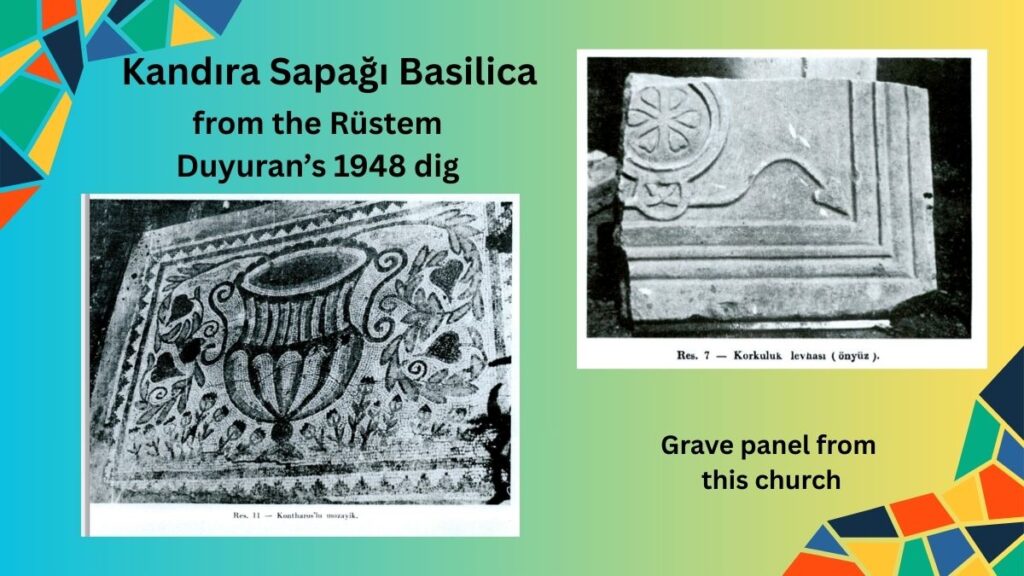
Church of the Apostles (5th century)
In the 7th century, George Eleusios a disciple of Theodore of Sykeon wrote about his bishop and teacher. In this writing, he mentions this church.[6]Theodore of Sykeon died in 613 Since he wrote about life during the 6th century, this church most likely connects to this century or the one before it (5th). There is historical evidence of this church, but no archaeological evidence, but I have guessed that this could be Kandıra Sapağı Basilica.
The words In the Life of Theodore of Sykeon says, “…he went to Nicomedia and entered the church of the Apostle…”[7]Elizabeth Dawes & Norman H. Baynes, Three Byzantine Saints: Contemporary Biographies of St Daniel the Stylite, St Theodore of Sykeon and St John the Almsgiver (Oxford: Basil Blackwell, 1948; … Continue reading These words affirm the known existence of this church and the importance of Bishop Theodore in entering it. Unfortunately, no location is mentioned.
Gültepe Necropolis Basilica
In looking at the Churches of Nicomedia, we find many in this ancient Necropolis area. A cross-plan church (haç-planlı kilise) has been found in the middle of the Necropolis.[8]YouTube drone footage: https://youtu.be/4HR4s1xcyzM?si=mx_IXOsHWtwRC7k6 This small church, based on found articles and its construction, is from the 4th or 5th century.[9]https://kocaeliansiklopedisi.com/Default/MaddeDetay/539?utm_source=chatgpt.com At the same time, the martyrium also found there, with frescoes, is from later Byzantine times. In my list, these are listed separately. Many pictures are available on the DHL Turkish news site.[10]https://www.dha.com.tr/foto-galeri/31-yil-once-kesfedilen-gultepe-nekropolu-sahipsiz-kaldi-2068135/5
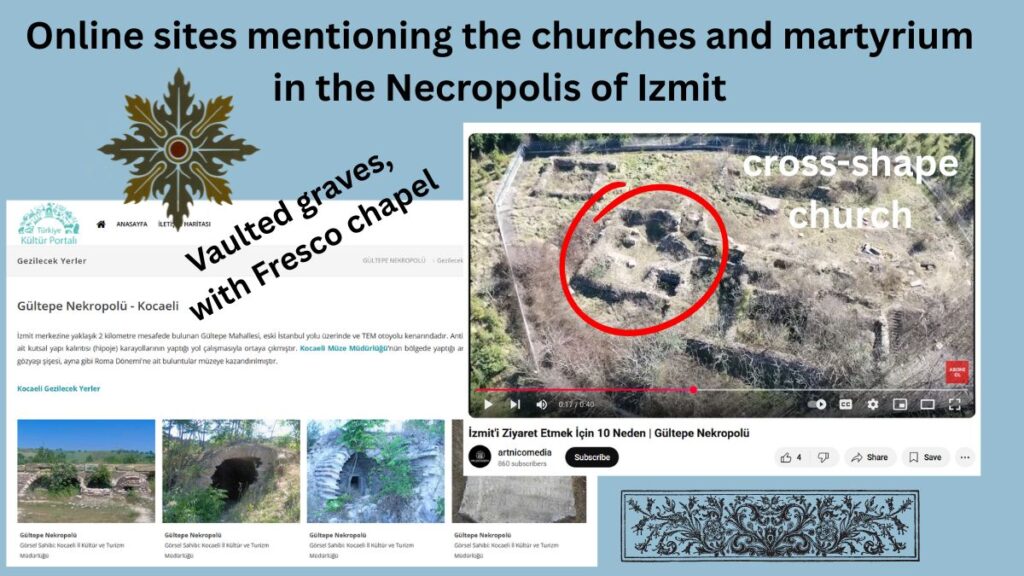
This area has been classified as a first degree archeology site but the overgrowth of vegetation and trees has again covered up the history located there.[11]https://www.arkeolojikhaber.com/haber-izmitte-1400-yillik-kilise-bulunan-yer-1-derece-arkeolojik-sit-alani-oldu-36691 Much looting and destruction has taken place on this isolated area so what can be recovered may have already taken place.
Now, let us explore the later churches of Nicomedia in part two, focusing on these Byzantine churches.
For the more adventurous, I have put together a walking tour of the sites. However, many sites could be enclosed or hard to find.
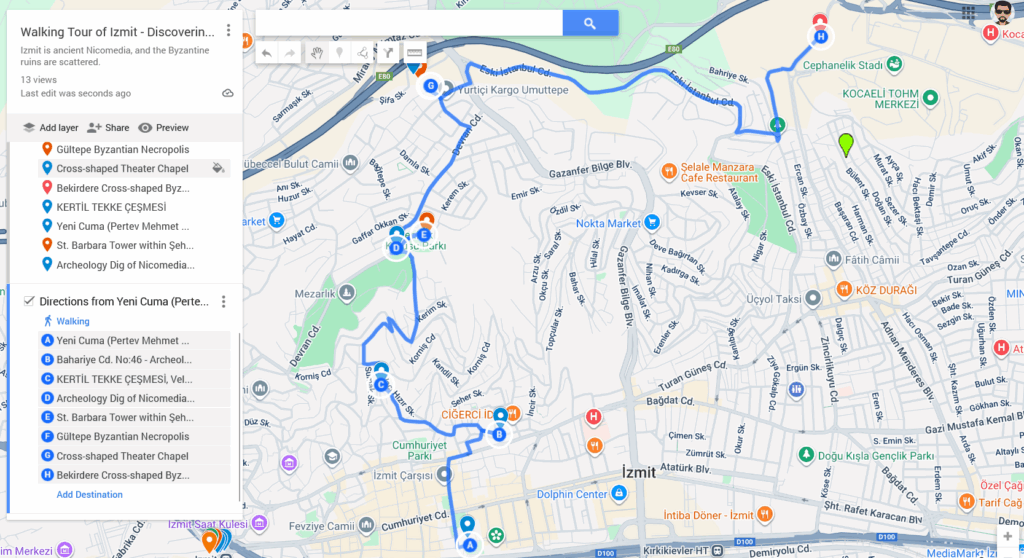
References
| ↑1 | Another monastery was called Passion of Indes (eunuch who served Domna) and Domna (a known virgin, secretly converts, she is the king’s concubine – an official from Maximian’s rule who was martyred with her eunuch.) This monastery became a nunnery for women. |
|---|---|
| ↑2 | R. Duyuran’s 1951 report (Belleten XV/58, p. 214–215):“Kandıra Sapağı’nda yapılan kurtarma kazılarında üç nefli ve üç apsisli bir yapı ortaya çıkarılmış olup, plan özellikleri itibarıyla bazilika olarak değerlendirilmektedir.” |
| ↑3 | See: https://dergipark.org.tr/tr/download/article-file/3313802 |
| ↑4 | see Duyuran 1951, 213-8 |
| ↑5 | Fatih Camii is the location of the Istanbul Church of the Apostles |
| ↑6 | Theodore of Sykeon died in 613 |
| ↑7 | Elizabeth Dawes & Norman H. Baynes, Three Byzantine Saints: Contemporary Biographies of St Daniel the Stylite, St Theodore of Sykeon and St John the Almsgiver (Oxford: Basil Blackwell, 1948; repr. St Vladimir’s Seminary Press, 1977), Life of Theodore of Sykeon, ch. 156, pp. ~128–132. |
| ↑8 | YouTube drone footage: https://youtu.be/4HR4s1xcyzM?si=mx_IXOsHWtwRC7k6 |
| ↑9 | https://kocaeliansiklopedisi.com/Default/MaddeDetay/539?utm_source=chatgpt.com |
| ↑10 | https://www.dha.com.tr/foto-galeri/31-yil-once-kesfedilen-gultepe-nekropolu-sahipsiz-kaldi-2068135/5 |
| ↑11 | https://www.arkeolojikhaber.com/haber-izmitte-1400-yillik-kilise-bulunan-yer-1-derece-arkeolojik-sit-alani-oldu-36691 |
Leave a Reply